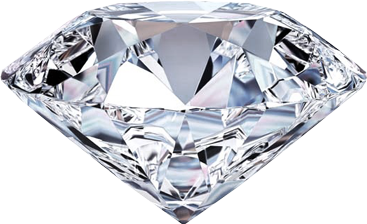Asscher Cut Diamonds | In-Depth Guide, Proportions, L/W Ratio
Asscher Cut Diamonds | In-Depth Guide, Proportions, L/W Ratio
Posted by Sharif Khan on 7th Dec 2022
Asscher Cut Diamond Buying Guide
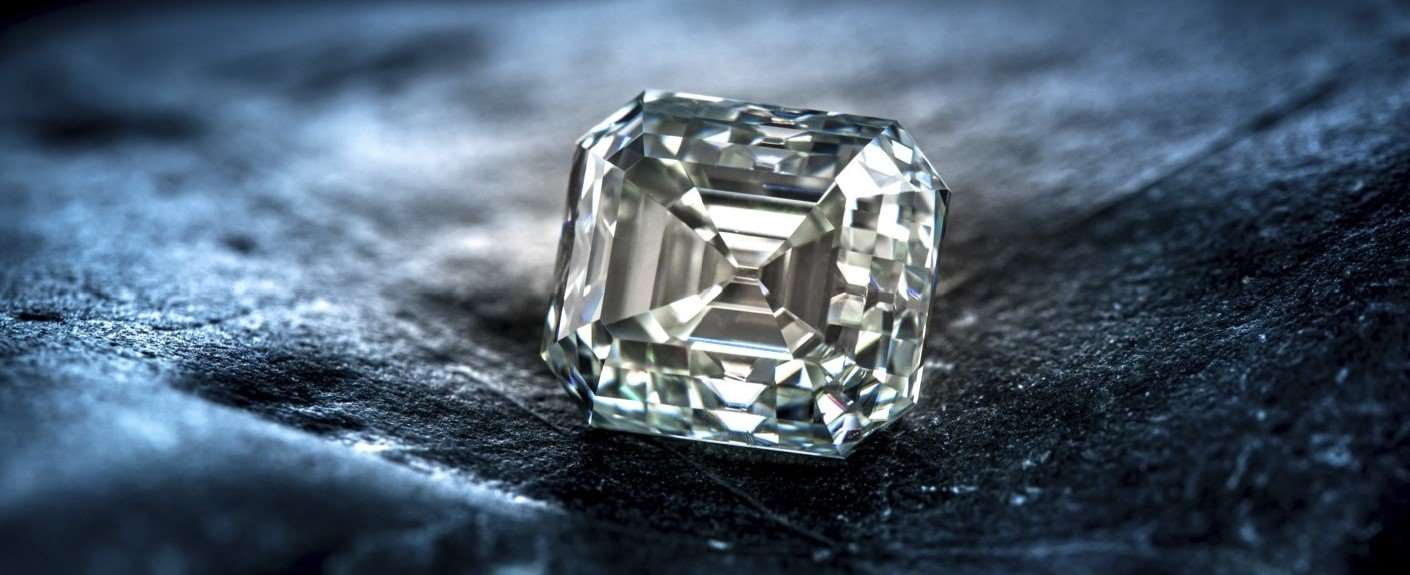
Named after the Royal Asscher Diamond Company, the Asscher cut was considered a revolutionary concept when it was created. While its popularity faded in the last century, Asscher cut diamonds are now considered a popular diamond shape. The demand for this shape particularly increased in early 2002, mostly because cut modifications gave the diamond more brilliance.
The open facets of Asscher cut diamonds create seemingly endless hallways lined with reflective mirrors, radiating elegant fire and brilliance. The modern Asscher cut diamond shares similar features with a square emerald cut diamond, with a smaller table, a higher crown, and larger step facets. Properly positioned pavilion facets create lovely concentric squares in the Asscher cut diamond. Besides the square shape of the Asscher cut, cropped corners give the cut a unique octagonal shape. When placed in a four-prong setting, the Asscher cut will maintain its shape within a square silhouette.
Assess the quality of Asscher cut diamonds with exceptional 40X MAGNIFIED VIDEOS.
Key Points to Know
- Cut: Ideal Depth: 61-67%, Table: 62-70%, Length-to-Width Ratio: 1-1.05.
- Color: Ideal choices include D-F colorless diamonds, G provides great value, and H/I is an exceptional budget option.
- Clarity: Opt for a high clarity grade in Asscher cuts, considering their open facets, with a minimum VS2 grade.
- Fluorescence: Avoid it in colorless diamonds while being flexible in H or lower color grades.
- Certification: Buy an Asscher cut diamond with a full GIA grading report.
The 4Cs can be prioritized in four primary ways while buying an Asscher cut diamond. To prioritize quality, consider an Asscher cut like this: EXAMPLE 1, VVS/D-E range; to maximize size and quality, consider this: EXAMPLE 2, VS/F-G range; to get the largest possible stone while still maintaining quality, consider this: EXAMPLE 3, SI1/H-I range; and to compromise on one C and maximize on other 3Cs, buy a lower color grade Asscher cut diamond with exceptional quality and cut like this: EXAMPLE 4, VVS-VS/J-M range.
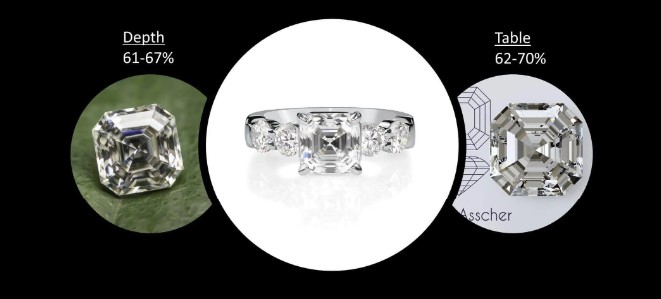
Asscher Cut Diamond Highlights
| Shape | Asscher shaped diamonds are among the most popular diamond shapes. The Asscher cut is an ideal choice for lovers of a step and antique shape. |
| Cut | While evaluating the cut, a depth of 60% to 68% and a table of 61% to 71% are recommended for the Asscher shaped diamonds, with a tolerance of 1-2% (up or down). See our proportions chart below for more insights. |
| Color | D-F colors are considered colorless, while " G" is also a great color. Moreover, "H" and I colors are great budget options. |
| L/W Ratio | A length-to-width ratio of 1 to 1.05 is ideal. See more below. |
| Clarity | Flawless to VVS clarity grades are exceptional. VS1 and VS2 are also safe grades for Asscher cut. When considering SI1 and SI2 clarity grades, carefully evaluate the diamonds to ensure the stone is eye clean. Given the open facets, we recommend buying a high clarity grade asscher cut diamond. |
| Fluorescence | Avoid fluorescence in the "D" to "G" color range; up to medium blue is safe in "H", "I", and lower color grades. |
| Certification | Buy a GIA or AGS-graded Asscher cut diamond. Read our instructions on how to read a grading report below carefully. |
| Settings | Both classic and modern settings suits Asscher cut diamonds nicely. Consider halo settings for smaller Asscher cut diamonds. Here is a list of our top Asscher cut engagement rings. |
| Best Places | Here is a list of our best places to buy diamonds online. |
Ideal Asscher Cut Proportions
The chart below serves as a general guideline when evaluating the cut of an Asscher cut diamond. For example, a 1.00 length-to-width ratio is considered classic for a square shape in the Asscher cut. While slightly rectangular shapes exist among Asscher cut diamonds, a ratio of 1.05 or less will appear square to the naked eye.
|
Depth %
Poor/Fair: <52 or >80 / 52-80 Good: 57-59 / 71-74.5 Very Good: 58.8-70/67-70.1 Excellent: 61.3-67 |
Table %
Poor/Fair: <50 or >80/50-52.5 or 75.5-80 Good: 53-57/74 Very Good: 58-61/71 Excellent: 62-70 |
|
Culet
Poor/Fair: Very Large/Large Good: Slightly Large Very Good: Medium/Very Small Excellent: None |
Girdle
Poor/Fair: Ex. Thin – Ex. Thick Good: Very Thin – Thick Very Good: Very Thin – Slightly Thick Excellent: Very Thin – Slightly Thick |
|
L/W Ratio
Poor/Fair: >1.09 /1.07-1.09 Good: 1.05-1.06 Very Good: 1.00-1.04 Excellent: 1.00-1.04 |
Color in Asscher Cut Diamonds
Color is a critical factor in Asscher cut diamonds. Like other diamond shapes, color in an Asscher cut diamond is subjective. Our experience indicates that many buyers prefer warmer colors over cooler ones due to affordability. In the color spectrum, the former (warmer colors) refer to G-I diamonds, whereas the latter (cooler colors) refer to D-F diamonds. On the positive side, the price premium for H and I color grade Asscher cut diamonds is significantly lower than for D-E color diamonds.
Fluorescence in a diamond is often a negative factor. However, it can be helpful to warmer color diamonds because blue is a complementary color to yellow, making a diamond with a yellow hue appear whiter than its actual color grade.
For more detailed information on the color of an Asscher cut diamond, use the table below.
|
< 0.50 Carat
Poor/Fair: >M/ L-M Good: J-K Very Good: H-I Excellent: D-G |
0.51 – 1.0 Carat
Poor/Fair: J-K / >L Good: I-J Very Good: H Excellent: D-G |
|
1.0 – 2.0 Carat
Poor/Fair: H-I / >I Good: G Very Good: D-F Excellent: D-F |
>2.0 Carat
Poor/Fair: H-I / >I Good: G-H Very Good: F Excellent: E-F |
|
Fluor.
Poor/Fair: Very/Strong Good: Medium Very Good: Faint Excellent: None |
Clarity in Asscher Diamonds
Since Asscher cut diamonds have open facets, we recommend buying a slightly higher clarity Asscher cut diamond. Our customers have a unique standard for clarity and color; some want flawless diamonds, while others are comfortable with inclusions if they are not noticeable to the naked eye. Select the clarity grade of an Asscher cut diamond based on our guidance outlined below.
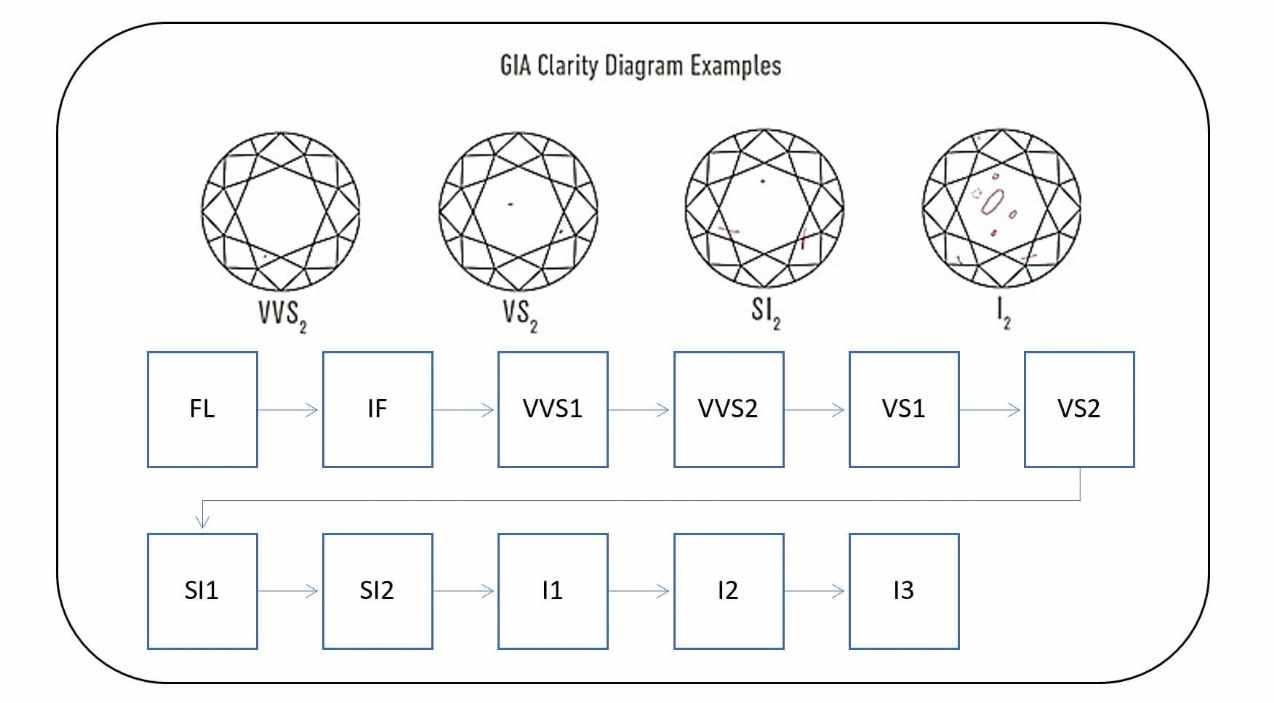
SI1 would have an outstanding balance of price and appearance in an Asscher cut. However, we recommend VS2 or above in 1.5+ carat diamonds because Asscher cut diamonds have open facets.
|
< 0.50 Carat
Poor/Fair: >I1/ I1 Good: SI2 Very Good: SI1 Excellent: FL-VS2 |
0.51 – 1.0 Carat Poor/Fair: SI2-I2 / > SI2 Good: SI1 Very Good: VS2-SI1 Excellent: FL-VS1 |
|
1.0 – 2.0 Carat
Poor/Fair: SI2-I1 / >I1 Good: SI1 Very Good: VS2 Excellent: FL-VS1 |
>2.0 Carat
Poor/Fair: SI2 / >SI2 Good: SI1 Very Good: VS1-VS2 Excellent: FL-WS2 |
How to Read the Grading Report
In addition to the well-known 4Cs, buyers must acquaint themselves with the subsequent pivotal facets of an asscher cut diamond grading report or certificate, as the image below underscores.

Watch the HD VIDEO of this diamond.
Measurements: This holds great significance as it furnishes the buyer with information regarding the diamond's surface size (indicating its apparent size in millimeters). Moreover, it provides the length-to-width ratio by dividing the length by the width (in this case, it calculates to 6.36/6.35=1).
Fluorescence: This aspect ought to be considered the fifth C. Given that the color is G, none or faint fluorescence is the best choice in this specific example. Nevertheless, moderate blue fluorescence is not as concerning as strong blue fluorescence.
Comments: This section will exhibit clarity-related factors and illuminate whether a diamond has undergone clarity enhancement, employing methods such as laser drilling or color enhancement. Additionally, pay heed to comments like "clarity grade based on clouds," which is a troubling indicator within clarity grades of VS2 and below. The laser inscription of the report number on the girdle is positioned above the comments section, providing an optional service for added verification.
Proportions: This chart assumes the utmost importance in evaluating the cut of a diamond. Concretely, focus on the table percentage (64% in the example - excellent), depth percentage (68.2% - excellent), girdle (medium to slightly thick - excellent), and culet (none - excellent).
Clarity Characteristics: This section will denote the types of inclusions and their respective locations. It can aid buyers in evading diamonds with noticeable inclusions at the center. Furthermore, these details prove valuable for establishing a connection between the report and the diamond, as these inclusions function as the diamond's unique birthmarks.
Recommended Budget Choices
Below are general guidelines for navigating the 4Cs within a tight budget. For more information, read this article on how to prioritize the 4Cs.
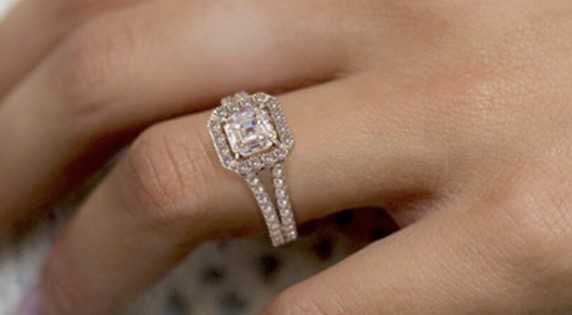
Asscher Shaped Split Band Engagement Ring (WATCH IN HD).
Excellent Choice
- At least 1.2 carats in Weight
- Very Good to Excellent Polish and Symmetry
- G or above in color
- SI1 or above in clarity
- No Fluorescence
- Length/width ratios: 1-1.04
Very Good Choice
- At least 1 Carat in Weight
- Good to Excellent Polish and Symmetry
- H or above in Color
- SI1 or above in Clarity
- None, faint or medium blue fluorescence
- Length/width ratios: 1-1.04
Good Choice
- At least 0.90 Carats in Weight
- Good to Very Good Polish and Symmetry
- I or above in Color
- SI1 or above in Clarity
- None, faint or medium blue fluorescence
- Length/width ratios: 1-1.04
While working with a tight budget, consider lab-grown diamonds as an alternative. Besides James Allen, Blue Nile is an excellent company for buying lab diamonds.

